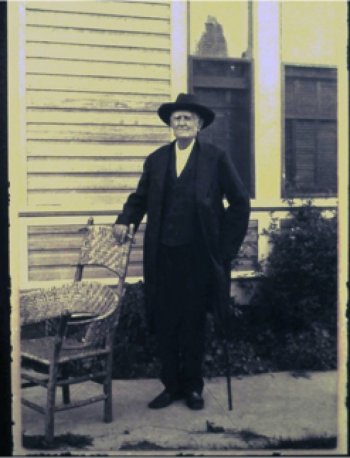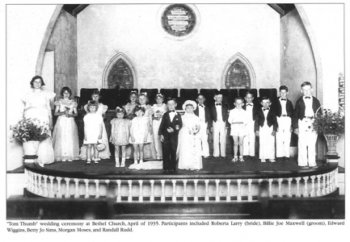Wilson Dabney Sims was about twenty-seven years old when he came to Texas with his father and siblings in 1851. He was born in Maury County, Tennessee on October 3, 1824. After arriving in Ellis County he continued to live with his parents, John and Elizabeth, on Chambers Creek and worked on the farm for the family interest. After several years of labor, his father gave him $500 with which W. Dabney conducted his first land purchase of two hundred sixteen acres on March 21, 1857. He paid $2.50 an acre.i He set about making improvements on the land but continued to live with his parents until after the Civil War.
Civil War Involvement
During the Civil War, Ellis County contributed fighting men to the Confederate Cause through the Twelfth Texas Cavalry Regiment of the Army of the Trans-Mississippi. Commanded by Colonel William Henry Parsons, the Twelfth Cavalry became known as “Parsons’s Brigade.” Discrepancies exist concerning W. Dabney’s service in the War. The sketch in the Memorial and Biographical History of Ellis County states that he “enlisted in Company F in Parson’s Cavalry Regiment and served in Louisiana, Arkansas, and Texas. He was mustered in and discharged at Hempstead, was neither wounded nor taken prisoner, and continued to the close of the war.”ii His obituary in the Waxahachie Enterprise on May 16, 1892 also stated that he served through the war in Parson’s Brigade; however, the source of information for the obituary was probably the sketch in the Memorial and Biographical History of Ellis County. It is clear that W. Dabney did indeed enlist in Parson’s Brigade; however his Confederate service record states that he served as a corporal in Capt. J.C. Brown’s Company. Brown commanded company “E”, the Ellis County Grays. Therefore, W. Dabney could not have served in company “F” as his biographical sketch stated. His service record indicates that he enrolled at Camp Hebert near Hempstead on October 28, 1861, and his term of enlistment was for twelve months.iii However, he did not serve the entire year. His muster card records that he enlisted on August 10, 1861 at Waxahachie and was mustered in on August 23, 1861 at Camp Tarrant. He was then discharged at Camp Hebert on October 28, 1861 after serving two months and six days. His name does not appear on any of the known rosters for Parson’s Brigade, which further supports the assertion that he served a only short time. As a matter of interest, his muster card indicates that at the time of his discharge W. Dabney owned one horse valued at $170, horse equipment valued at $30, guns at $45, and one pistol at $60.iv The Confederate government had little money to fund an army, so soldiers supplied their own horses, equipment, and munitions.
One possible explanation for his short term of service could be that he became ill at camp. Camp Hebert was located on the Sims Bayou about eight miles from Houston. In fall 1861, the weather was recorded as being particularly foggy and dismal.v Because of the damp, rainy conditions many men became sick and died. It is probable that W. Dabney was among those casualties, and he returned home to recuperate. Around May 25, 1861 more men were organized into the army under the Conscript Act. As fresh replacements came in, the veterans who had served their year went home, and many did not re-enlist.vi After his recuperation he probably was not required to return to the cavalry since his term of service was up, and he may not have wanted to return after experiencing the discomforts of camp life.
Life After the Civil War
After the Civil War, the South experienced great economic hardship. Southerners made sacrifices in support of the War, and as a result of their defeat many were in financial ruin. Confederate script was useless, and the destruction of property was enormous. Ellis County was more fortunate than much of the South because Texas was not turned into a battleground. The men of Parson’s Brigade were proud of this fact, because their efforts had prevented the union army from crossing the Texas border. The most significant loss most people experienced in Ellis County was the forfeiture of their slaves. The loss of labor presented many challenges as former masters and slaves worked out new work and social contracts.
W. Dabney continued to live with his parents after the War, and didn’t marry until later in life. He married his first wife, Sally High, in 1871 when he was forty-six years old, and she was twenty. They had one daughter, Sallie. Unfortunately, both mother and daughter died in April 1873. The cause of death is not recorded, but it is logical to conclude that they both perished from illness in the same month. In 1875, W. Dabney married Sally’s younger sister, Bettie High. Bettie was eighteen years old when they married. From this union they had two children, Bessie and Lou Ella. Bettie died in 1879 after four years of marriage. Their daughter, Bessie, died in 1891 at the age of fifteen. W. Dabney then married Evelyn Whitfield one year after the death of Bettie in March 1880. They were married eleven years before W. Dabney died at the age of sixty-seven years. W. Dabney and Evelyn had three children: Minnie Evelyn (1880-1959), Wilson Dabney (1883-1956), and Patrick Whitfield (1887-1936).vii
In spite of the toll of post-war Reconstruction, the Sims family thrived. In 1876, W. Dabney made several land purchases totaling five hundred sixty acres. On January 29, 1878 he bought the Merlin land grant from his uncle, Nicholas Sims. In all, W. Dabney eventually owned some 5500 acres of land in Ellis County.viii

Establishing a Home
W. Dabney chose to make his home on the Merlin survey property. Since water was a key element for survival, he built his house at a remote location on a spring and created a cistern dug out of solid rock. The house was a single-story frame structure that was updated and remodeled several times. The old homestead still stands and retains some of its original features, such as high ceilings, original floors, and original foundation timbers. Because of the remote location of the homestead, it was difficult for the children to attend school. The Sims solved this problem by hiring a live-in tutor for a time to educate the children.
A draw was located to the east of the house, and across the draw the Sims built a row of houses for tenant farmers. Since they were built in a straight line, they became known as “Stringtown.”ix The Merlin survey was never worked by slave labor since its cultivation occurred after the Civil War. However, the 1870 and 1880 censuses record many black individuals with the last name of “Sims” living near the Sims family. The proximity of black Sims individuals to white Sims families indicates that many stayed with their former masters as tenant farmers. The pre-Civil War slave schedules do not record any personal data of slaves beyond their race, age, and gender. The post-Civil War censuses give the former slaves some identity, with names such as Simeon, Keziah, Fannie, and Maggie. These censuses also record their birthplaces, and group them according to families. This information confirms that these individuals were former Sims’ slaves because the oldest ones were born in Lafayette County, Mississippi.x

A Difficult Way of Life
Life in the late nineteenth century was difficult and often a struggle just to survive. The number of W. Dabney’s wives and the deaths of two of his children illustrate the high mortality rate of that time. Nicholas Sims was married twice, and his second wife was married four times. Farmers faced the challenges of nature every day. Texas climate can be capricious and unforgiving. In Ellis County, the years of 1854-1860 were so dry that many farmers began growing barley in place of the usual corn crop. The year 1857 was unusually cold while the summer of 1860 recorded searing temperatures up to one hundred twelve degrees. The dry conditions resulted in frequent prairie fires caused by spontaneous combustion. In January 1879, temperatures dipped to two degrees. A flood was recorded in 1887, and the next year there was so much rain that people reported floating on rafts above the telephone poles on Chambers Creek. February 1898 set the record as one of the most frigid spells the county had ever experienced, with temperatures falling to ten degrees below zero.xi
One of the worst of nature’s ravages, though, was the legendary locust plague in the fall of 1876. The skies darkened with the insects, and they dropped to the earth to a depth of several inches. The horde ate everything green and any natural fibers they could find, such as curtains and clothing. They then deposited their eggs and died. The stench of the dead insects was terrible. Even worse, poultry and pigs gobbled up the insects, tainting their flesh with an unpleasant taste. Their meat was inedible for months. The locust eggs then hatched from February to April 1877. By May, the locusts moved on, leaving a barren earth behind them.xii
These examples illustrate some of the challenges faced by the pioneers of Ellis County. However, in spite of adversity, the Sims families thrived and prospered. The 1860 Agricultural Census shows that John and Nicholas were already well on their way to prosperity. At this time, W. Dabney was still living with his parents. He had just begun to work his land, so his production is not at the same level as his father’s and uncle’s. Still, the figures demonstrate that he had already accumulated a considerable amount of land, and he had significant potential earnings.
1860 Agricultural Censusxiii
|
John Dabney Sims |
Nicholas P. Sims |
Wilson Dabney Sims |
|
|
Improved acres |
400 |
200 |
40 |
|
Unimproved acres |
800 |
718 |
876 |
|
Land cash value |
$6,000 |
$2,756 |
$832 |
|
Horses |
4 |
11 |
0 |
|
Milk cows |
25 |
34 |
2 |
|
Asses and mules |
6 |
3 |
1 |
|
Working oxen |
20 |
6 |
0 |
|
Other cattle |
75 |
46 |
2 |
|
Sheep |
100 |
500 |
0 |
|
Swine |
100 |
100 |
0 |
|
Livestock value |
$2,700 |
$2,530 |
$200 |
|
Wheat |
4,000 bushels |
715 bushels |
0 |
|
Rye |
75 bushels |
100 bushels |
0 |
|
Corn |
2,500 bushels |
400 bushels |
0 |
|
Oats |
400 bushels |
0 |
0 |
By 1880, W. Dabney owned fifty acres of tilled land. This figure did not include his total land holdings, but only that which he had tilled and planted with crops. The Agricultural Census records that sixteen of his acres produced fifty bushels of Indian corn, and fourteen acres produced two bales of cotton. He owned livestock worth $30 and farm machinery worth $14. He also held six barnyard poultry that produced fifty eggs in 1879.xiv The year of this census was the year following his purchase of the Merlin survey from his Uncle Nicholas, so he was still in the early stages of the development of his farm.
W. Dabney’s father, John, died in 1879. In his will he left W. Dabney $2,500 in gold as well as a total of 235 acres of land from various surveys including the L. B. De Spain survey. He disposed of the rest of his property to his children and grandchildren. W. Dabney wisely invested his funds. After January 1880, he conducted approximately thirty property purchases.xv

A Lifetime of Accomplishments
The history of the Sims family demonstrates that faith was an important element in their life. In 1851, few churches had been established in Ellis County. As a result, it was difficult for worshipers to congregate. Farmers and rural dwellers faced an additional challenge because they lived in remote areas removed from any community that would have a church. The Sims families recognized the need for congregational worship after they had newly arrived in Ellis County. In 1853, a brush arbor revival meeting resulted in the founding of Bethel Church at Greathouse, southwest of Waxahachie. The Sims families helped in its establishment. The following family members are listed as charter members: E. M. Brack and wife, Maria Sims, J.D. Sims and family, N. P. Sims and wife, and P.C. Sims and wife. N.P. Sims gave ten acres for the establishment of the church and cemetery. W. Dabney Sims was recorded as one of the church’s most supportive members. When things were needed at the church, he would say, “Get it. I will pay for it.”xvi Over the years, the congregation has taken the church through several iterations of building and rebuilding, but it is still standing today. Several charter members are buried in Bethel Cemetery, including W. Dabney who is buried beneath a large, decorative headstone.xvii
Besides farming, W. Dabney showed abilities as a competent businessman. His scope of interests far exceeded just farming the land in Italy. He owned a cotton gin for his own use, thereby saving the money required to have his cotton ginned at a secondary location. He served as the director and principal projector of the First National Bank in Waxahachie, which at that time had a capital of $100,000. He held the role of a stockholder of the bank at Bryant, Texas, which also had a capital of $100,000. In addition to these accomplishments, he had two residences and an office in Waxahachie, two offices in Italy with fifty acres of land adjoining, and one office in Milford. At one point, W. Dabney received appointment to the office of County Commissioner by the Provisional Judge, Jack Hamilton.xviii W. Dabney’s civic and religious contributions to the development of Ellis County were significant. Men like him and his Uncle Nicholas played a large role in taming a wild land and creating a cultured society in Ellis County. These pioneers left a legacy for the benefit of future generations.
A Legacy Passed to the Children
Wilson Dabney Sims died on May 10, 1892. At the time of his death, he had four living children: Louella, age fourteen; Minnie, age twelve; Wilson Dabney (W.D.), age eight; and Patrick, age five. His wife, Evelyn, raised the children on her own. After Minnie married, Evelyn lived in Waxahachie with her and Minnie’s husband until her death on December 20, 1911 at the age of sixty-two.
Minnie, W.D., and Patrick all attended Southwestern University in Georgetown, Texas. While a student, Patrick showed musical prowess and participated as a vocalist. He was a member of the college Conservatory as a vocalist and was a second tenor in the Glee Club. W.D. participated more in the social aspects of college life. He was a member of the Southwestern University Iota Chapter of the Kappa Sigma fraternity. He also served as an officer in a tongue-in-cheek organization called the Anvil Corps. Dabney’s membership in the Corps demonstrated his appreciation for irony, and provides some insight into his character. The Anvil Corps’ stated purpose was the “Furtherance of Local Gossip and Discouragement of Women’s Rights.” Their motto read “Knock or the world knocks with you.” W.D. held the title “His Majesty, the Sledge Hammerer.” Other officer titles included Heap Big Steam Hammerer, The Steady Knocker, The Occasional Knocker, and The Tapper.xix It is not surprising that the membership role did not include any women.
W.D. may have had a satirical sense of humor, but he was also considered to be a man of sterling character. Judge A.R. Stout mentioned him by name in The History of Ellis County. Stout wrote that W.D. Sims was in the company of the kind of men who were “influential in all things, both political and otherwise, because of the example they have furnished by the kind of life they have lived. They have never sought any office, unless it was a thankless one such as town councilman or school trustee, but they have lived for the betterment of their community and have helped make it and all about it a finer place in which to live.”xx This high praise attests to the exceptional character of the members of the Sims family.
i1 Memorial and Biographical History of Ellis County, Texas (Chicago: Lewis Publishing Company, 1892). 253.
ii2 Ibid.
iii3 Wilson D. Sims Confederate Service Record. www.fold3.com/image/#10218132.
iv4 Ancestry.com Texas, Muster Roll Index Cards, 1838-1900 [database on-line], Provo, UT, USA: Ancestry.com Operations, Inc., 2011.
v5 Lillie Tolleson, “Civil War and Reconstruction,” The History of Ellis County, Texas (Waco: Texian Press, 1972), 40.
vi6 Ibid.
vii7 Memorial and Biographical History of Ellis County, 253.
viii8 Ellis County Clerk, Index to Deeds, S Grantees, From 1845, Ellis County, Texas.
ix9 Campbell family, “History of the Dabney Sims House”, 1994.
x10 Ancestry.com 1870 United States Federal Census [database on-line], Provo, UT, USA: Ancestry.com Operations, Inc., 2009; Ancestry.com 1880 United States Federal Census [database on-line], Provo, UT, USA: Ancestry.com Operations, Inc., 2010.
xi11 Ruth Stone, “Beginning of Ellis County,” The History of Ellis County, Texas, 4.
xii12 Ibid.
xiii13 Ancestry.com Selected U.S. Federal Census Non-Population Schedules, 1850-1880 [database on-line] Provo, UT, USA: Ancestry.com Operations, Inc., 2010.
xiv14 Ibid.
xv15 Ellis County Clerk, Index to Deeds, S Grantees, From 1845, Ellis County, Texas.
xvi16 Mrs. Dunaway, “History of Bethel Church,” History of Ellis County, Texas (Waco: Texian Press, 1972), 30-33.
xvii17 Ancestry.com U.S. Find a Grave Index, 1600s-Current [database on-line], Provo, UT, USA: Ancestry.com Operations, Inc., 2012.
xviii18 Memorial and Biographical History of Ellis County, Texas (Chicago: Lewis Publishing Company, 1892). 253-254.
xix19 Ancestry.com U.S. School Yearbooks, 1880-2012 [database on-line]. Provo, UT, USA: Ancestry.com Operations, Inc., 2010.
xx20 A.R. Stout, “Political History,” History of Ellis County, Texas (Waco: Texian Press, 1972), 283.





